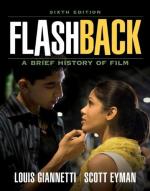
|
| Name: _________________________ | Period: ___________________ |
This test consists of 15 multiple choice questions and 5 short answer questions.
Multiple Choice Questions
1. What editor displayed the emotional impact of crowd scenes on film?
(a) Lev Kulshov.
(b) Fritz Lang.
(c) F.W. Murnau.
(d) Sergei Einstein.
2. What fear arose about an audience's viewing experience as films grew longer?
(a) They would demand their money back.
(b) They would start getting bored.
(c) It would be harder to follow the plot.
(d) They would dislike the actors.
3. Upon whose model of mass production did the Hollywood studio system manufacture films in the Golden Age?
(a) F.W. Murnau.
(b) Thomas Edison.
(c) Eli Whitney.
(d) Orson Welles.
4. What was Harold Lloyd's trademark?
(a) Dance.
(b) Glasses.
(c) Laugh.
(d) Hat.
5. What was Harry Langdon's film persona?
(a) The baby.
(b) The ladies' man.
(c) The swashbuckler.
(d) The tramp.
6. What was one reason comedy shorts became so popular in the 1920s?
(a) The stories were presented in serial format.
(b) The tabloid era had begun.
(c) The actors all had scandalous lives.
(d) The audiences did not need to follow a plot.
7. What was one of the biggest threats to the film industry in the 1930s?
(a) Salaries.
(b) Censorship.
(c) Filming on location.
(d) The war.
8. For what reason did many great artists leave Europe for America in the 1930s?
(a) Nazi persecution.
(b) Political exiling.
(c) Low production values.
(d) The studios lured them to America.
9. Through what did Jean Louis Meissonier project Muybridge's work?
(a) Zoetrope.
(b) Glass lantern.
(c) Rotoscope.
(d) Rear projector.
10. In the first several decades of the film industry, European films focused on the artists, while American films focused on the _______.
(a) Sociological value.
(b) Political statements.
(c) Story.
(d) Entertainment.
11. What did Griffith as a director discover that elevated films from being more than technical achievements?
(a) Talented actors.
(b) Prohibition forced people into the theaters.
(c) Special effects and lighting.
(d) Cinematography.
12. With what film technique did European filmmakers begin experimenting?
(a) Sound.
(b) Special effects.
(c) Editing.
(d) Cinematography.
13. What event in America caused studios to realize that the movie-going public needed entertainment over grim realism?
(a) World War II.
(b) World War I.
(c) The Great Depression.
(d) Prohibition.
14. What was Charlie Chaplin's film persona?
(a) The swashbuckler.
(b) The baby.
(c) The tramp.
(d) The ladies' man.
15. What style of art influenced Alfred Hitchcock the most, particularly in his early work?
(a) Expressionism.
(b) Theater of Cruelty.
(c) Theater of the Absurd.
(d) Brechtian.
Short Answer Questions
1. From what entertainment aspect did Orson Welles tap in order to innovate the ways films were made?
2. Which world-class, renowned filmmaker stayed made propaganda films for Hitler?
3. What sort of films did Jean Cocteau create in France in the 1930s?
4. As studios struggled to find the balance between pragmatism and idealism in the early decades of the Golden Age, which of the following people was not one of the great directors to innovate filmmaking in this period?
5. Why did the War Department in America ban some of the political movies made during World War II?
|
This section contains 500 words (approx. 2 pages at 300 words per page) |

|




